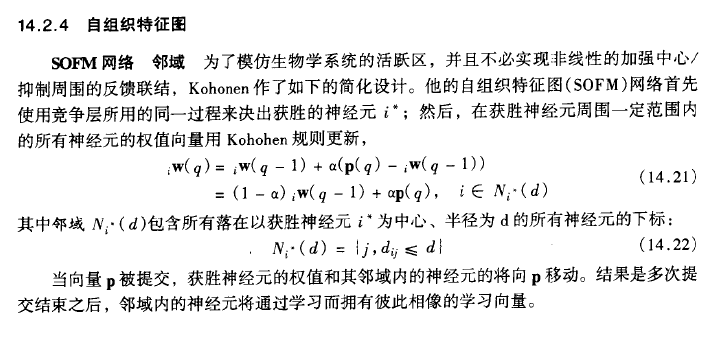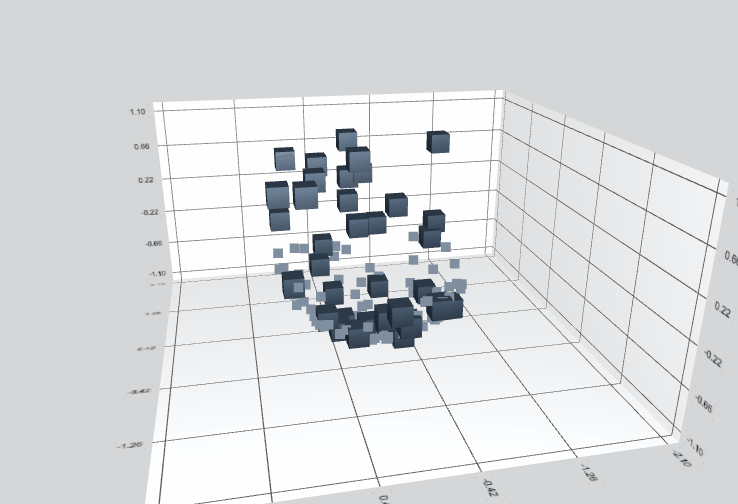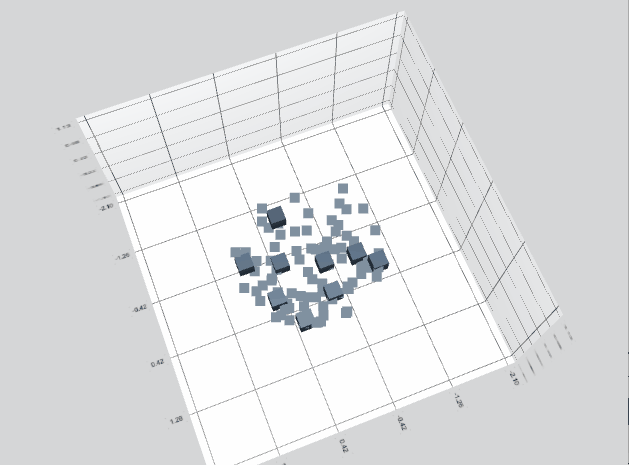这里直接给出Qt代码段和演示结果。
理论部分请移步另一位博主的 自组织特征图(SOFM)详解_datamonday的博客-CSDN博客_sofm算法
算法基于 Martin H. Hagan 的《神经网络设计》 第十四章竞争网络实现。其中按照原书,使用相关性(Wp)而不是距离(||W-P||)作为获胜判定。以后将在学习向量量化(LVQ)网络中使用距离

算法改进包括:
引入逐渐变小的学习步长
引入墨西哥草帽函数实现“加强中心/抑制周围”
参考代码 AANN_sofm::initNeighborMatrix_MexicoStrawHat(int N)
引入良心变数(conscience),并限制良心变数使用的频率
使用胜出训练参数和需要调整的W(i)之间的距离来决定学习步长a,否则在实践中会发现向量很难收敛在训练数据集形成的曲面上。
(auto a = (P.transpose() - m_layer.W.row(maxIndex)).squaredNorm()/(0.01+m_layer.W.row(maxIndex).squaredNorm());)
AANN_sofm.h 文件
#ifndef AANN_SOFM_H
#define AANN_SOFM_H
#include <list>
#include <vector>
#include <Eigen/Dense>
#include "QEigenExt.h"
using namespace Eigen;
#include "AANN_instar.h"
/**
*
* 自联想神经网络(Auto-Associative Neural Network , 缩写为AANN)
* 是1987年Ballard提出的,其网络原型是一种具有对称拓扑结构的五层前馈传递网络,
* AANN 应用到数据检验问题时具有比较明显的物理意义。是BP神经网络的一种特殊情形。
* 其特点是有对称拓扑结构,即输出量等于输入量。
*/
class AANN_sofm
{
public:
AANN_sofm();
public:
// int GetLayerNum() const;
// bool AppendLayer(AANN_LAYER_PARAM_F layer);
virtual bool train( const Eigen::VectorXf &P, int N );
virtual bool calc( const Eigen::VectorXf &P, Eigen::VectorXf *A = NULL );
float getAlpha( ) const;
float getGamma( ) const;
long getRound( ) const;
void setAlpha( const float alpha);
void setGamma( const float gamma);
bool setNeighborMatrix( const MatrixXf neighbors );
bool initNeighborMatrix( int N, int type );
bool initNeighborMatrix_MexicoStrawHat( int N );
bool initNeighborMatrix_Sombrero( int N );
const MatrixXf getWMatrix() const;
private:
void init();
private:
// AANN_LAYER_LIST_F m_layerList;
AANN_LAYER_PARAM_F m_layer;
float m_alpha;
float m_gamma;
long m_round;
};
#endif // AANN_SOFM_H
AANN_sofm.cpp文件
#include "AANN_sofm.h"
#include "activation.h"
#include <iostream>
#include <time.h>
#include <stdio.h>
AANN_sofm::AANN_sofm()
{
m_alpha = 0.5f;
m_gamma = 0.5f;
init();
}
void AANN_sofm::init()
{
m_layer.maxB = -1;
m_layer.func = hardlim;
m_round = 0;
}
float AANN_sofm::getAlpha( ) const
{
return m_alpha;
}
float AANN_sofm::getGamma( ) const
{
return m_gamma;
}
long AANN_sofm::getRound( ) const
{
return m_round;
}
void AANN_sofm::setAlpha( const float alpha)
{
m_alpha = alpha;
}
void AANN_sofm::setGamma( const float gamma)
{
m_gamma = gamma;
}
bool AANN_sofm::setNeighborMatrix( const MatrixXf neighbors )
{
if( !neighbors.size() || neighbors.rows() != neighbors.cols())
{
return false;
}
m_layer.Neighbors = neighbors;
qDebug() << QString( " --------------- neighbors %1 x %2 ---------------" )
.arg(neighbors.rows()).arg(neighbors.cols());
for(int row=0; row<neighbors.rows(); row++ )
{
VectorXf r = neighbors.row(row);
qDebug() << " " << r;
}
return true;
}
/**
* @brief AANN_sofm::initNeighborMatrix
* set neighbor matris for SOFM
* @param eMat
* EX: the neighbor pointers about 7 will be 2,6,8,12
* All others will be like so
* 0 1 2 3 4
* ^
* 5 6 < 7 > 8 9
* v
* 10 11 12 13 14
* 15 16 17 18 19
* 20 21 22 23 24
*
* Then, neighbor Matrix will be
* 0 1 2 3 4 5 6 7 8 9 10 11 12 ..... 20 21 22 23 24
* +----+----+----+----+----+----+----+----+----+----+----+----+----+----+----+----+----+----+----+----+
* 0 | 1 1 0 0 0 1 0 ..... 0 0 0 0 0
* 1 | 1 1 1 0 0 0 1 0 ..... 0 0 0 0 0
* 2 | 0 1 1 1 0 0 0 1 0 ..... 0 0 0 0 0
* 3 | 0 0 1 1 1 0 0 0 1 0 ..... 0 0 0 0 0
* 4 | 0 0 0 1 1 0 0 0 0 1 0 ..... 0 0 0 0 0
* 5 | 1 0 0 0 0 1 1 0 0 0 1 0 ..... 0 0 0 0 0
* 6 | 0 1 0 0 0 1 1 1 0 0 0 1 0 ..... 0 0 0 0 0
* 7 | 0 1 0 0 0 1
* 8 | 0 1 0 0 0
* 9 | 0 1 0 0
* 10 | 0 1 0
* . | 0 1
* . |
* . |
* . |
* . |
* 22 | 0 0 0 0 0 0 0 0 0 0 0 0 0 ... 0 1 1 1 0
* 23 | 0 0 0 0 0 0 0 0 0 0 0 0 0 ... 0 0 1 1 1
* 24 | 0 0 0 0 0 0 0 0 0 0 0 0 0 ... 0 0 0 1 1
*/
bool AANN_sofm::initNeighborMatrix( int N, int type = 0 )
{
Q_UNUSED( type );
if( N <= 0 || N > 10000 )
{
return false;
}
MatrixXf neighbor = MatrixXf::Identity( N*N, N*N ) - MatrixXf::Ones( N*N, N*N )/((N+4)*(N+4));
for( int row = 0; row < N*N; row++)
{
int x = row%N;
int y = row/N;
if( (y+N-1)%N < y )
{
neighbor( ((y+N-1)%N)*N+x, row ) = 1.f/((N+1)*(N+1));
}
if( (y+1)%N >y )
{
neighbor( ((y+1)%N)*N+x, row ) = 1.f/((N+1)*(N+1));
}
if( (x+N-1)%N < x )
{
neighbor( row, y*N+(x+N-1)%N ) = 1.f/((N+1)*(N+1));
}
if( (x+1)%N > x ) {
neighbor( row, y*N+(x+1)%N ) = 1.f/((N+1)*(N+1));
}
}
return setNeighborMatrix( neighbor );
}
bool AANN_sofm::initNeighborMatrix_MexicoStrawHat( int N )
{
if( N <= 0 || N > 10000 )
{
return false;
}
MatrixXf neighbor = MatrixXf::Identity( N*N, N*N );
for( int row = 0; row < N*N; row++)
for( int col = row+1; col < N*N; col++)
{
int dx = row%N - col%N;
int dy = row/N - col/N;
float d1 = 1+dx*dx+dy*dy;
float d2 = (dx*dx+dy*dy)*d1*d1;
neighbor( row, col ) = neighbor( col, row ) = (1.0f/d2 - 0.07f)/d1;
}
return setNeighborMatrix( neighbor );
}
/**
* @brief AANN_sofm::initNeighborMatrix_Sombrero
* refer to https://baike.baidu.com/item/Sombrero%20function/16550687
* @return
*/
bool AANN_sofm::initNeighborMatrix_Sombrero( int N )
{
if( N <= 0 || N > 10000 )
{
return false;
}
MatrixXf neighbor = 0.98*MatrixXf::Identity( N*N, N*N );
for( int row = 0; row < N*N; row++)
for( int col = row+1; col < N*N; col++)
{
int dx = row%N - col%N;
int dy = row/N - col/N;
float d2 = dx*dx+dy*dy;
float d1 = sqrt( d2 );
float d4 = exp(2*d2);
// float cc = cos( (3.14f/2-0.1)*d1 );
// float dd = cc/d4;
neighbor( row, col ) = neighbor( col, row ) = cos( (3.14159/2-0.01)*d1 )/d4;
}
return setNeighborMatrix( neighbor );
}
const MatrixXf AANN_sofm::getWMatrix() const
{
return m_layer.W;
}
/**
* @brief AANN_sofm::train
* @param P measured vector : 可度量特征信息:如形状,味道,温度,颜色,重量等
* @param T 感知的结果,或期望的结果
* @return
*/
bool AANN_sofm::train( const Eigen::VectorXf &P, int S )
{
const int R = P.rows();
/* return false if input Dim is different */
if( S <= 0 )
{
return false;
}
/* return false if input Dim is different */
if( ( m_layer.W.cols() > 0 ) && ( m_layer.W.cols() != R ) )
{
return false;
}
/* return false if output Dim is different */
if( ( m_layer.W.rows() > 0 ) && ( m_layer.W.rows() != S ) )
{
return false;
}
if( m_layer.Neighbors.size() && (m_layer.Neighbors.rows() != S || m_layer.Neighbors.cols() != S ))
{
return false;
}
if( S != m_layer.W.rows() || R != m_layer.W.cols() )
{
srand( time(NULL) );
m_layer.W = MatrixXf::Random( S, R );
m_layer.Conscience = VectorXf::Ones( S );
}
int maxIndex;
m_layer.N = (m_layer.W * P).array() + R;
/**
* @brief round_mask
* 随着训练次数增长,应用良心的间隔越来越大,但总是有机会使用
* M = 3 时
* m_round : 0~7 8~15 16~31 32~63 ... 2^(n+3) ~ 2^(n+3)-1
* N : 0 1 2 4 ... 2^n
* round_mask : 0x...FFFFF 1 3 7 ... (2^(n+1))-1
* apply conscience : 8 x 8 x 8 x 8 x ... 8 x
* M = 6 时
* m_round : 0~63 64~127 128~255 256~511 ... 2^(n+6) ~ 2^(n+6)-1
* N : 0 1 2 4 ... 2^n
* round_mask : 0x...FFFFF 1 3 7 ... (2^(n+1))-1
* apply conscience : 64 x 64 x 64 x 64 x ... 64 x
*
* 应用良心的频率随 M 的增加而呈指数增加,测试中 M=3 能得到比较好的性能
*/
static int round_mask = 1;
int N = m_round >> 3;
if( 0 == ( N&(N-1) ) )
{
round_mask = (N<<1)-1; // 0,1,2,4,8,16,...
}
if( 0 == ( m_round & round_mask ) )
{
(m_layer.N.array() * m_layer.Conscience.array()).maxCoeff(&maxIndex);
} else {
m_layer.N.maxCoeff(&maxIndex);
}
m_layer.A = VectorXf::Zero(S);
m_layer.A[maxIndex] = 1;
m_layer.Conscience = m_layer.Conscience.array()/(1+m_layer.A.array()).array();
m_layer.Conscience.normalize();
VectorXf vecA;
if( m_layer.Neighbors.rows() == S )
{
// vecA = ( m_layer.Neighbors * m_layer.A ).unaryExpr(std::ref(satlin<float>));
vecA = (m_layer.Neighbors * m_layer.A).normalized();
} else {
vecA = m_layer.A;
}
/*
* delta W = W(q) - W(q-1) = alpha * A(q) * P(q) - gamma * A(q).diagonal * W(q-1)
*/
auto a = (P.transpose() - m_layer.W.row(maxIndex)).squaredNorm()/(0.01+m_layer.W.row(maxIndex).squaredNorm());
a = fmin( 1.0, fmax( a, m_alpha ));
m_layer.deltaW = a * vecA * P.transpose() - a * vecA.asDiagonal() * m_layer.W;
m_layer.W = (m_layer.W + m_layer.deltaW);//.rowwise().normalized();
m_round++;
return true;
}
/**
* @brief AANN_sofm::calc
* @param P measured vector : 可度量特征信息:如形状,味道,温度,颜色,重量等
* @return
*/
bool AANN_sofm::calc( const Eigen::VectorXf &P, Eigen::VectorXf *A )
{
AANN_LAYER_PARAM_F layer = m_layer;
Eigen::VectorXf e;
const int R = P.rows();
/* return false if input Dim is different */
if( ( m_layer.W.cols() <= 0 ) || ( m_layer.W.cols() != R ) )
{
qWarning() << QString( __FUNCTION__ " : Error! input dim is different : expect %1, but input data is %2 " )
.arg(m_layer.W.cols()).arg( R );
return false;
}
qDebug() << __FUNCTION__ " --- CALC -----------------------";
qDebug() << __FUNCTION__ " P = " << P.eval() ;
m_layer.A = (m_layer.W * P).unaryExpr(std::ref(m_layer.func));
qDebug() << __FUNCTION__ " A = " << m_layer.A;
if( A ) { *A = m_layer.A; }
return true;
}
线程执行代码段:
void DataWorker::on_start()
{
for(int k = 0; !m_bUserQuit && (k < 100000); k++ ) // while( false == m_bUserQuit )
{
updateNnData();
QThread::msleep(10);
}
}
#define N 3
void DataWorker::reset()
{
m_sofm.initNeighborMatrix_Sombrero(N);
}
void DataWorker::updateNnData( )
{
QMutexLocker locker( &m_nnLocker );
float r = sqrt(m_sofm.getRound()) ;
float alpha = (r+500.0f)/( 100*r+1000.0f);
m_sofm.setAlpha( alpha );
m_sofm.setGamma( alpha );
#define PI 3.14159265358979
{
float a = - acos(sqrt( (rand() % 257) / 256.0001)); // -3.14 * (rand() % 256) / 512.0;
float b = PI * (rand() % 12345) / 1000.0;
VectorXf P(3);
P << cos(a)*sin(b), sin(a), cos(a)*cos(b);
if(m_trainSetModel && ( m_sofm.getRound() < 10000) )
{
// WData d(cos(a)*sin(b), cos(a)*cos(b), sin(a));
m_trainSetModel->append( WData(P[0],P[1],P[2]));
m_trainSetModel->dataChanged( m_trainSetModel->index(0,0), m_trainSetModel->index(-1,-1));
}
m_sofm.train( P, N*N );
}
m_dataModel->update(m_sofm.getWMatrix());
}以下是36点在半球形中的演示结果

以下是9点在半球形中的演示结果。看得出,用距离来决定学习步长在这时造成了结果的发散






















 2359
2359











 被折叠的 条评论
为什么被折叠?
被折叠的 条评论
为什么被折叠?








